Research on the Rule of Explosion Shock Wave Propagation in Multi-Stage Cavity Energy-Absorbing Structures
Abstract
1. Introduction
2. Experimental Design
2.1. Gas Explosion Experimental System
- (1)
- Multiple systems were connected, and the instrument was debugged to restore it to regular operation;
- (2)
- The diaphragm was inserted between the detonating tube and the connecting tube and seal with a sealing ring;
- (3)
- A gas distribution subsystem was used to arrange the gas, with a concentration of 9.5% in the detonating tube;
- (4)
- For 20 min, the circulating pump was used to circulate the gas in the pipeline;
- (5)
- The collection subsystem was debugged to the collection state;
- (6)
- For ignition, the ignition subsystem was used;
- (7)
- To preserve the acquired data, a data-processing system was used.
2.2. Plan for Single-Stage Cavity Experiment
2.3. Plan for Multi-Stage Cavity Experiment
3. Experimental Results and Analysis
3.1. Explosion Shock Wave and Flame Evolution Rule in Straight Pipes
3.2. The Flame Evolution Law of a Gas Explosion in a Single-Stage Cavity
3.3. Gas Explosion Shock Wave Evolution Rule in Multi-Stage Cavities
3.4. The Law of Evolution of a Gas Explosion Flame in a Multi-Stage Cavity
4. The Numerical Modeling of Shock Wave Propagation
4.1. Research Strategy for Numerical Simulation
4.2. Geometric Modeling and Mesh Generation
4.3. Mathematical Model
- (1)
- It was assumed that the gas explosion process was a perfect mechanism for gas thermal expansion;
- (2)
- It was assumed that the pipeline’s inner walls and the cavity’s interior surfaces were adiabatic, there was no heat exchange, the radiation heat release during the explosion shock wave propagation was disregarded, and the fluid–solid coupling effect between the inner wall and the shock wave was disregarded;
- (3)
- It was assumed that in an explosion, the gas, and air were mixed equally, in line with Moore’s rule, and in a stationary condition prior to igniting;
- (4)
- It was assumed that the shock wave created by the Mach rod was parallel to the inner wall and on a plane.
4.4. Dependability Assessment of Numerical Simulation
4.5. Numerical Simulation Results
4.5.1. Law of Shock Wave Propagation in a Single-Stage Cavity
- As seen in Figure 12b, as the shock wave entered the diffusion cavity, the cross-section abruptly rose, and the plane wave transformed into a spherical wave;
- The high-pressure region of the shock wave shifted towards both sides of the cavity, as shown in Figure 12c, as the spherical wave met the obstruction of the inner walls on both sides and emitted superposition. Sparse waves were generated at the cavity’s center, and the shock waves were then reflected and stacked on the inner wall of the cavity, creating a Mach reflection, which created overpressure concentration areas on both sides of the cavity structure and caused the shock waves to propagate forward;
- As seen in Figure 12d, as the shock wave approached the cavity’s outlet, a section of it suddenly contracted and was blocked by the inner wall of the outlet, creating a reflected wave at the outlet, while the overpressure concentration area on both sides of the inner wall advanced;
- As seen in Figure 12e, when the right angle inner wall of the cavity blocked the overpressure concentration region on both sides of the shock wave inner wall, it underwent complex reflection superposition. It created a 45° overpressure reflection zone on the inner wall;
- The reflection overpressure concentration region shifted toward the cavity’s center, as seen in Figure 12f, as did the area on each side where it was concentrated;
- A reverse shock wave was created at the cavity outlet’s center, as shown in Figure 12g, and the reverse shock wave and forward shock wave canceled each other out to lessen the shock wave;
- This caused emission superposition and a high-pressure concentration area on both sides of the inner outlet wall, as shown in Figure 12h when the reverse shock wave hit the inner wall obstruction at the inlet;
- As seen in Figure 12i, overpressure concentration zones resurfaced on both sides of the inner wall, and the shock waves canceled each other out;
- As illustrated in Figure 12j, the shock wave experienced several reflections and overlays within the cavity, and the combined action resulted in the cavity having a good reduction impact on the explosion shock wave.
4.5.2. Law of Shock Wave Propagation in a Multi-Stage Cavity
4.5.3. Uncertainty Analysis
- (1)
- The uncertainty of the explosion parameters, including the TNT equivalent, gas concentration, explosion distance, ambient pressure, temperature, and site conditions were all considered;
- (2)
- The unpredictability of the tunnel’s explosion shock wave flow field was considered;
- (3)
- The collection device’s uncertainty was considered.
5. Conclusions
- (1)
- Cavities 35, 55, 58, and 85 had a suppressive impact on explosive flames, but cavities 33, 38, 53, and 83 had an augmenting effect. The interaction of shock waves and explosion flames led the explosion flame to become unstable, resulting in turbulence and even the occurrence of a combustion-to-detonation transition. When detonation occurred, the cavity had an amplifying impact on the explosive flame. The cavity had a suppressive impact on the explosive flames when the shock wave’s high flow velocity lowered the combustion speed of the flame and prevented detonation;
- (2)
- The multi-stage cavity effectively lessened the explosion shock wave. The suppression rate of the 58-33 cavity with the best suppression of shock wave peak overpressure in the second cavity was 42.21%. With a suppression percentage of 54.74%, 58-35-55 had a good suppression impact on explosive shock waves. It was demonstrated through multi-cavity tests that linking numerous cavities in a series may substantially attenuate the explosion shock wave;
- (3)
- Most combination cavities benefitted from weakening explosive flames. The 58-35 cavity had the best flame suppression effect on the two-stage cavity, with a 93.38% explosive flame suppression rate. The 58-35-55 three-stage cavity suppressed flames well, with a suppression rate of 97.31%. It can be seen that the 58-35-55 cavity had a good suppression effect on the explosion shock wave and explosion flame;
- (4)
- According to the numerical modeling of the 5-8 single-stage cavity, the shock wave underwent complicated reflection and superposition, creating a reverse shock wave that effectively decreased the shock wave. The 58-58 cavity, 58-58-58 cavity, 58-58-58 cavity, and 58-58-58 cavity all reduced the explosion shock wave. The equation represents the link between its inhibition rate and the number of cavities. The 58-58 cavity is suggested due to its construction space and expense.
Author Contributions
Funding
Institutional Review Board Statement
Informed Consent Statement
Data Availability Statement
Acknowledgments
Conflicts of Interest
References
- Zhao, P.; Liu, H.; Ho, C.; Li, S.; Liu, Y.; Lin, H.; Yan, M. Evaluating Methane Adsorption Characteristics of Coal-Like Materials. Materials 2020, 13, 751. [Google Scholar] [CrossRef]
- Fang, X.; Jiang, B.; Yuan, L.; Liang, Y.; Ren, B.; Tao, W.; Li, X. Experimental Study on Atomization Characteristics of Gas–Liquid Two-Phase Flow Nozzle and Its Dust Removal Effect. Materials 2022, 15, 565. [Google Scholar] [CrossRef]
- Liu, W.; Xu, X.; Mu, C. Experimental Study on Two-Phase Explosion Suppression of Gas/Pulverized Coal by Explosion Suppressant. ACS Omega 2022, 7, 16644–16652. [Google Scholar] [CrossRef]
- Wang, Q.; Jiang, X.; Deng, J.; Luo, Z.; Wang, Q.; Shen, Z.; Shu, C.; Peng, B.; Yu, C. Analysis of the effectiveness of Mg(OH)2/NH4H2PO4 composite dry powder in suppressing methane explosion. Powder Technol. 2023, 417, 118255. [Google Scholar] [CrossRef]
- Luo, Z.; Su, Y.; Chen, X.; Zheng, L. Effect of BC powder on hydrogen/methane/air premixed gas deflagration. Fuel 2019, 257, 116095. [Google Scholar] [CrossRef]
- Wei, S.; Yu, M.; Pei, B.; Xu, M.; Guo, J.; Hu, Z. Experimental and numerical study on the explosion suppression of hydrogen/dimethyl ether/methane/air mixtures by water mist containing NaHCO3. Fuel 2022, 328, 125235. [Google Scholar] [CrossRef]
- Fan, R.; Jiang, Y.; Li, W.; Xiong, C.; Qiu, R. Investigation of the physical and chemical effects of fire suppression powder NaHCO3 addition on methane-air flames. Fuel 2019, 257, 116048. [Google Scholar] [CrossRef]
- Zhao, Q.; Chen, X.; Yang, M.; Zhang, H.; Huang, C.; Dai, H.; Li, Y.; Liu, J.; Zhu, H. Suppression characteristics and mechanisms of ABC powder on methane/coal dust compound deflagration. Fuel 2021, 298, 120831. [Google Scholar] [CrossRef]
- Song, Y.; Zhang, Q. The quantitative studies on gas explosion suppression by an inert rock dust deposit. J. Hazard. Mater. 2018, 353, 62–69. [Google Scholar] [CrossRef]
- Zhang, P.; Zhou, Y.; Cao, X.; Gao, X.; Bi, M. Mitigation of methane/air explosion in a closed vessel by ultrafine water fog. Saf. Sci. 2014, 62, 1–7. [Google Scholar] [CrossRef]
- Cao, X.; Wang, Z.; Lu, Y.; Wang, Y. Numerical simulation of methane explosion suppression by ultrafine water mist in a confined space. Tunn. Undergr. Space Technol. 2021, 109, 103777. [Google Scholar] [CrossRef]
- Pei, B.; Li, J.; Wang, Y.; Wen, X.; Yu, M.; Jing, G. Synergistic inhibition effect on methane/air explosions by N2-twin-fluid water mist containing sodium chloride additive. Fuel 2019, 253, 361–368. [Google Scholar] [CrossRef]
- Zhang, J.; Sun, Z.; Zheng, Y.; Su, Z. Coupling effects of foam ceramics on the flame and shock wave of gas explosion. Saf. Sci. 2012, 50, 797–800. [Google Scholar] [CrossRef]
- Shao, H.; Wang, C.; Yu, H. Effect of copper foam on explosion suppression at different positions in the pipe. Powder Technol. 2020, 360, 695–703. [Google Scholar] [CrossRef]
- Zhou, S.; Gao, J.; Luo, Z.; Hu, S.; Wang, L.; Su, B.; Li, R. Effects of mesh aluminium alloy and aluminium velvet on the explosion of H2/air, CH4/air and C2H2/air mixtures. Int. J. Hydrogen Energy 2021, 46, 14871–14880. [Google Scholar] [CrossRef]
- Cheng, F.; Chang, Z.; Luo, Z.; Liu, C.; Wang, T.; He, C. Large eddy simulation and experimental study of the effect of wire mesh on flame behaviours of methane/air explosions in a semi-confined pipe. J. Loss Prevent. Proc. 2020, 68, 104258. [Google Scholar] [CrossRef]
- Jianhua, S.; Yi, Z.; Chunrong, W.; Shang, X.; Donghui, H. The Comparative Experimental Study of the Porous Materials Suppressing the Gas Explosion. Procedia Eng. 2011, 26, 954–960. [Google Scholar] [CrossRef]
- Jiang, B.; Liu, Z.; Tang, M.; Yang, K.; Lv, P.; Lin, B. Active suppression of premixed methane/air explosion propagation by non-premixed suppressant with nitrogen and ABC powder in a semi-confined duct. J. Nat. Gas Sci. Eng. 2016, 29, 141–149. [Google Scholar] [CrossRef]
- Chen, X.; Zhang, Y.; Zhang, Q.; Ren, S.; Wu, J. Experimental investigation on micro-dynamic behavior of gas explosion suppression with SiO2 fine powders. Theor. Appl. Mech. Lett. 2011, 1, 32004. [Google Scholar] [CrossRef]
- Yang, K.; Zhang, P.; Yue, C.; Chen, K.; Ji, H.; Xing, Z.; Hao, Y.; Jiang, J. Experimental research on methane/air explosion inhibition using ultrafine water mist containing methane oxidizing bacteria. J. Loss Prevent. Proc. 2020, 67, 104256. [Google Scholar] [CrossRef]
- Luo, Z.; Wang, T.; Tian, Z.; Cheng, F.; Deng, J.; Zhang, Y. Experimental study on the suppression of gas explosion using the gas–solid suppressant of CO2/ABC powder. J. Loss Prevent. Proc. 2014, 30, 17–23. [Google Scholar] [CrossRef]
- Zhao, Q.; Li, Y.; Chen, X. Fire extinguishing and explosion suppression characteristics of explosion suppression system with N2/APP after methane/coal dust explosion. Energy 2022, 257, 124767. [Google Scholar] [CrossRef]
- Li, Y.; Bi, M.; Zhou, Y.; Gao, W. Hydrogen cloud explosion suppression by micron-size water mist. Int. J. Hydrogen Energy 2022, 47, 23462–23470. [Google Scholar] [CrossRef]
- Jing, Q.; Wang, D.; Liu, Q.; Chen, X.; Shen, Y.; Wang, Z.; Zhong, Y. Inhibition effect and mechanism of ultra-fine water mist on CH4/air detonation: Quantitative research based on CFD technology. Process Saf. Environ. 2021, 148, 75–92. [Google Scholar] [CrossRef]
- Lu, C.; Wang, H.; Pan, R.; Zhang, Y.; Yu, M. Preventing the propagation of gas explosion in ducts using spurted nitrogen. Process Saf. Environ. 2019, 123, 11–23. [Google Scholar] [CrossRef]
- Lu, C.; Zhang, Y.; Zhu, H.; Meng, Q.; Pan, R.; Yu, M. Spurting NH4H2PO4 Powder to Prevent the Propagation of Gas Explosion along the Duct. Combust. Sci. Technol. 2021, 193, 2534–2552. [Google Scholar] [CrossRef]
- Wang, F.; Jia, J.; Tian, X. Study on Methane Explosion Suppression in Diagonal Pipe Networks Using a Fine Water Mist Containing KCl and an Inert Gas. ACS Omega 2022, 7, 32959–32969. [Google Scholar]
- Addai, E.K.; Clouthier, M.; Amyotte, P.; Safdar, M.; Krause, U. Experimental investigation of limiting oxygen concentration of hybrid mixtures. J. Loss Prevent. Proc. 2019, 57, 120–130. [Google Scholar] [CrossRef]
- Niu, Y.; Shi, B.; Jiang, B. Experimental study of overpressure evolution laws and flame propagation characteristics after methane explosion in transversal pipe networks. Appl. Therm. Eng. 2019, 154, 18–23. [Google Scholar] [CrossRef]
- Liu, W.; Mu, C.; Li, Z. Influence of cavity structure on gas explosion characteristics in coal mine. Powder Technol. 2022, 398, 117084. [Google Scholar] [CrossRef]
- Chuan-Jie, Z.; Bai-Quan, L.; Bing-You, J.; Qian, L. Numerical simulation on oscillation and shock of gas explosion in a closed end pipe. J. Vib. Shock. 2012, 31, 8–12, 17. (In Chinese) [Google Scholar]
- De Levie, R. Curve fitting with least squares. Crit. Rev. Anal. Chem. 2000, 1, 59–74. [Google Scholar] [CrossRef]
- Chernov, N.; Huang, Q.; Ma, H. Fitting quadratic curves to data points. Br. J. Math. Comput. Sci. 2014, 1, 33–60. [Google Scholar] [CrossRef]
- Rosin, P.L.; West, G.A.W. Segmenting curves into elliptic arcs and straight lines. In Proceedings of the Third International Conference on Computer Vision, Osaka, Japan, 4–7 December 1990; IEEE Computer Society: Washington, DC, USA, 1990; pp. 75–78. [Google Scholar]
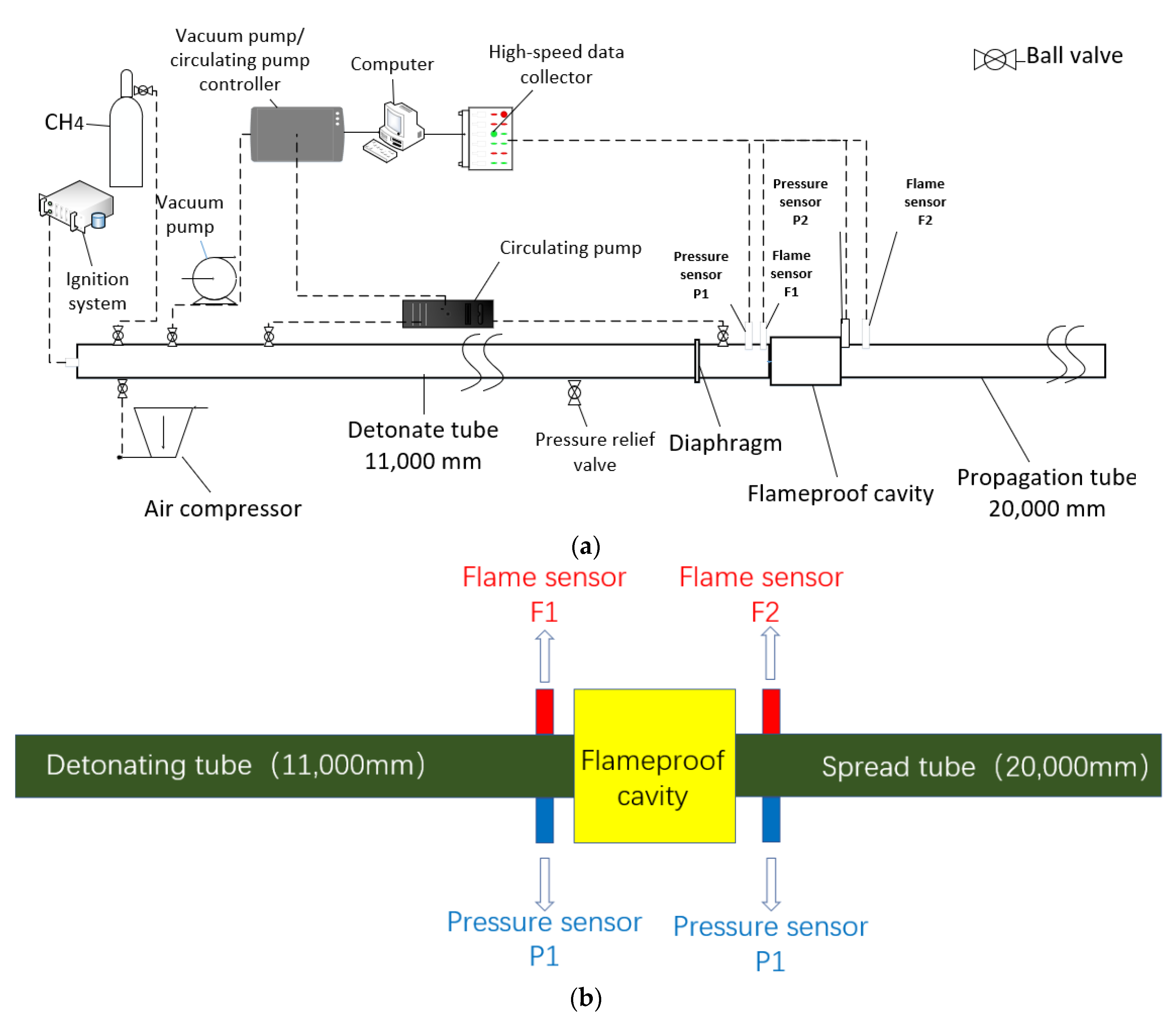

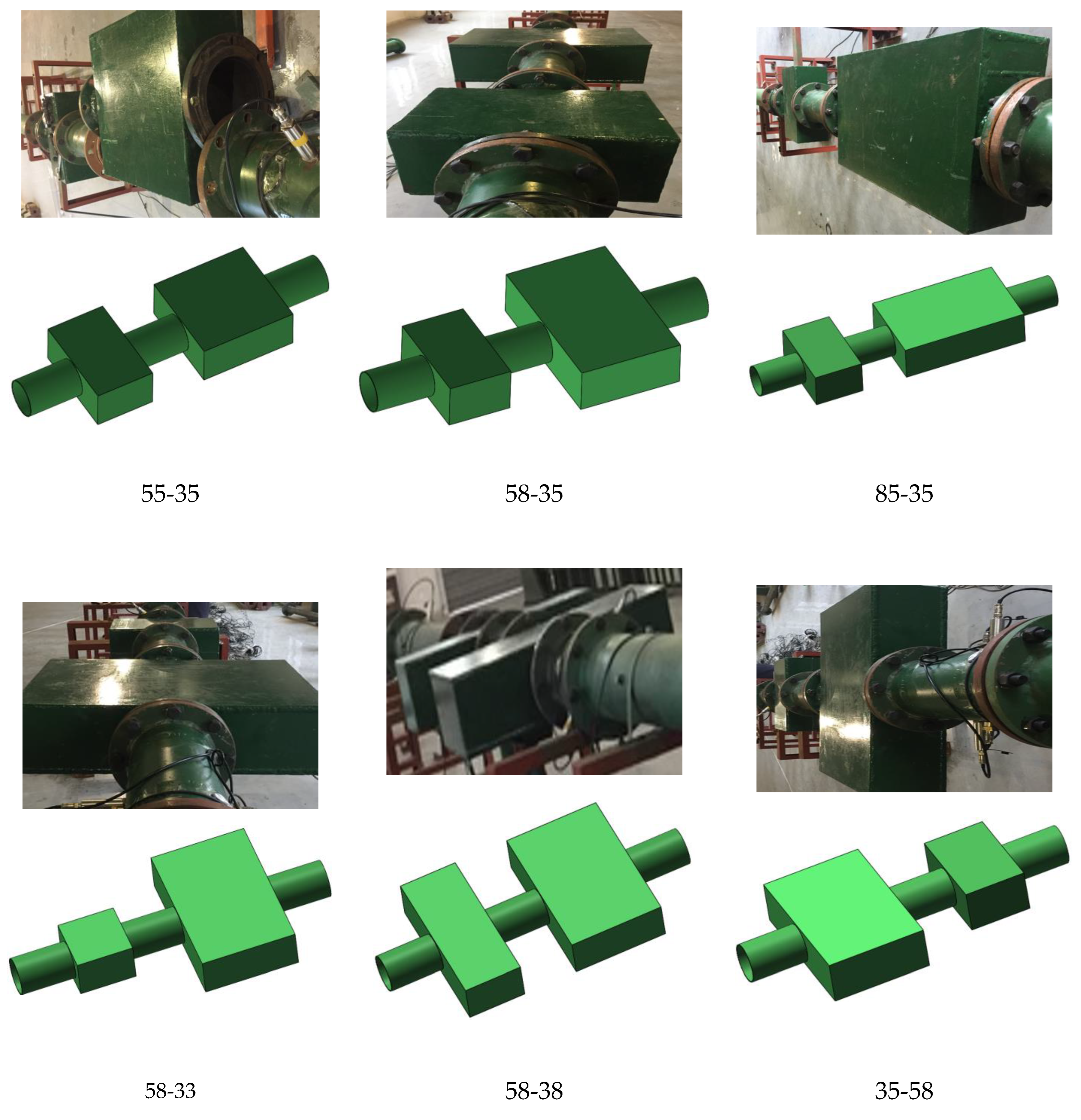

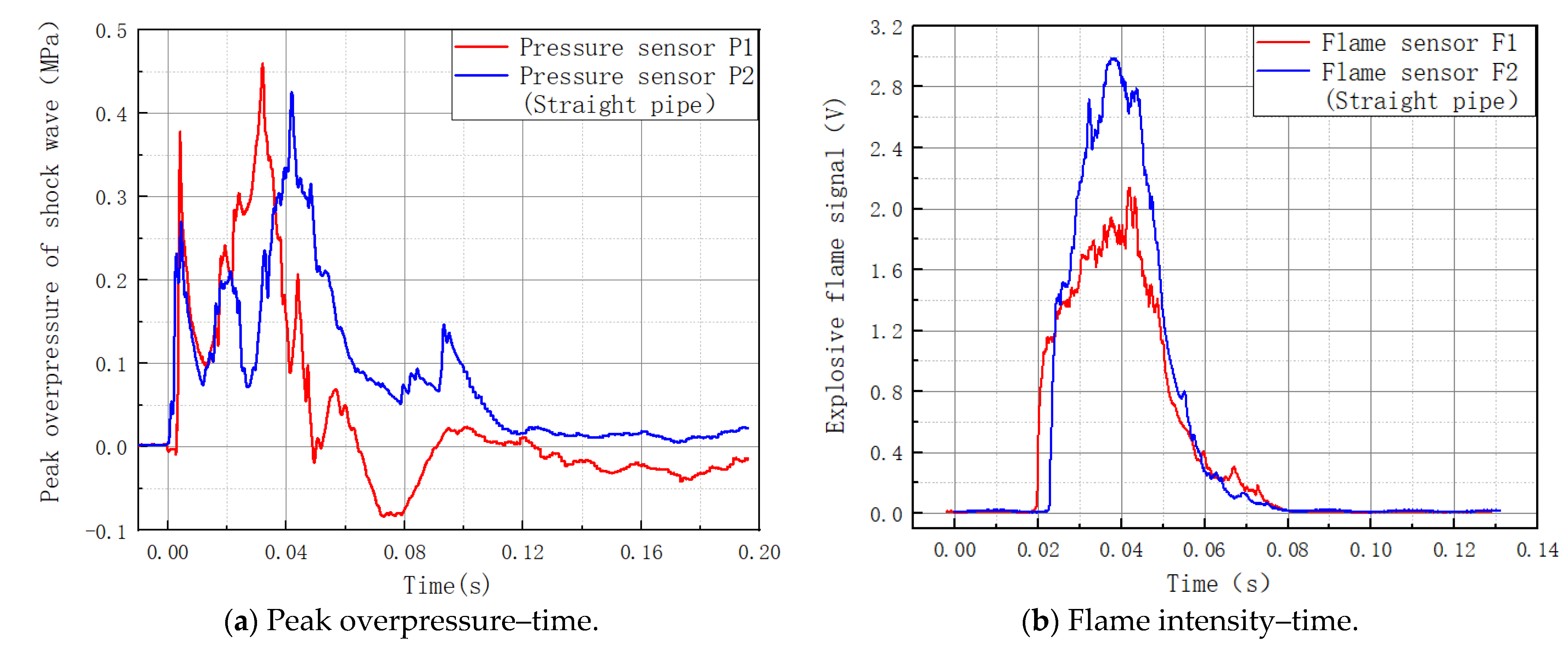
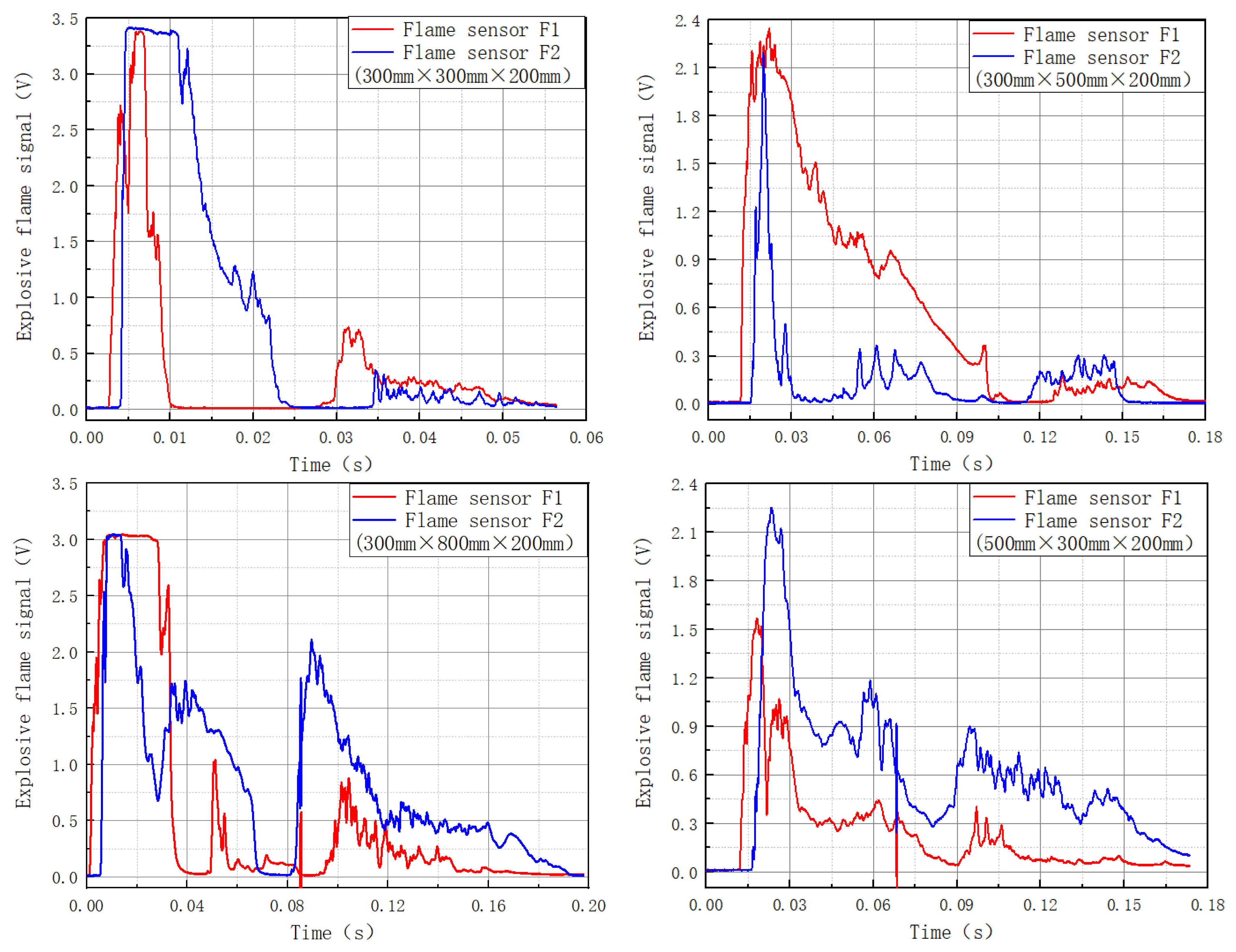
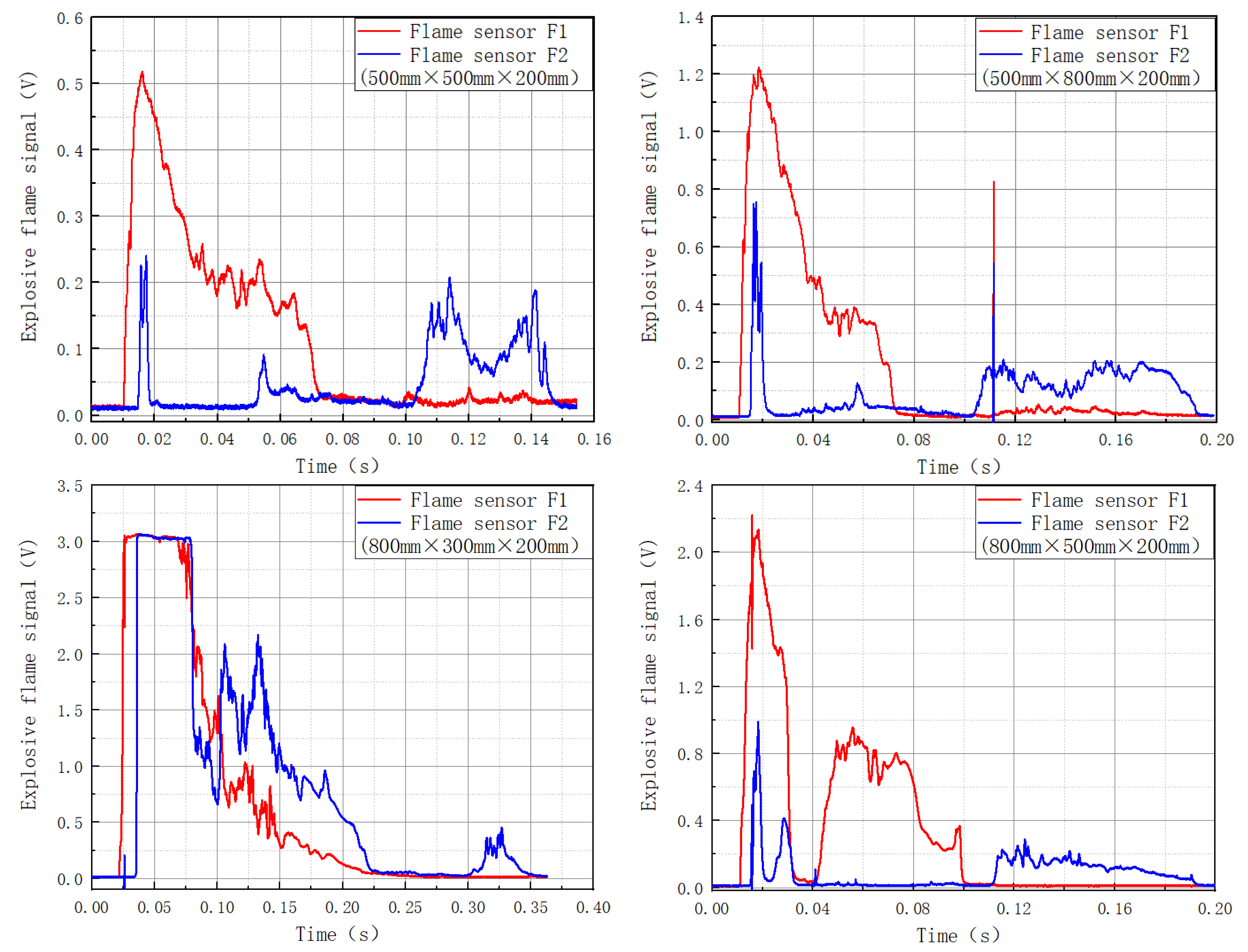
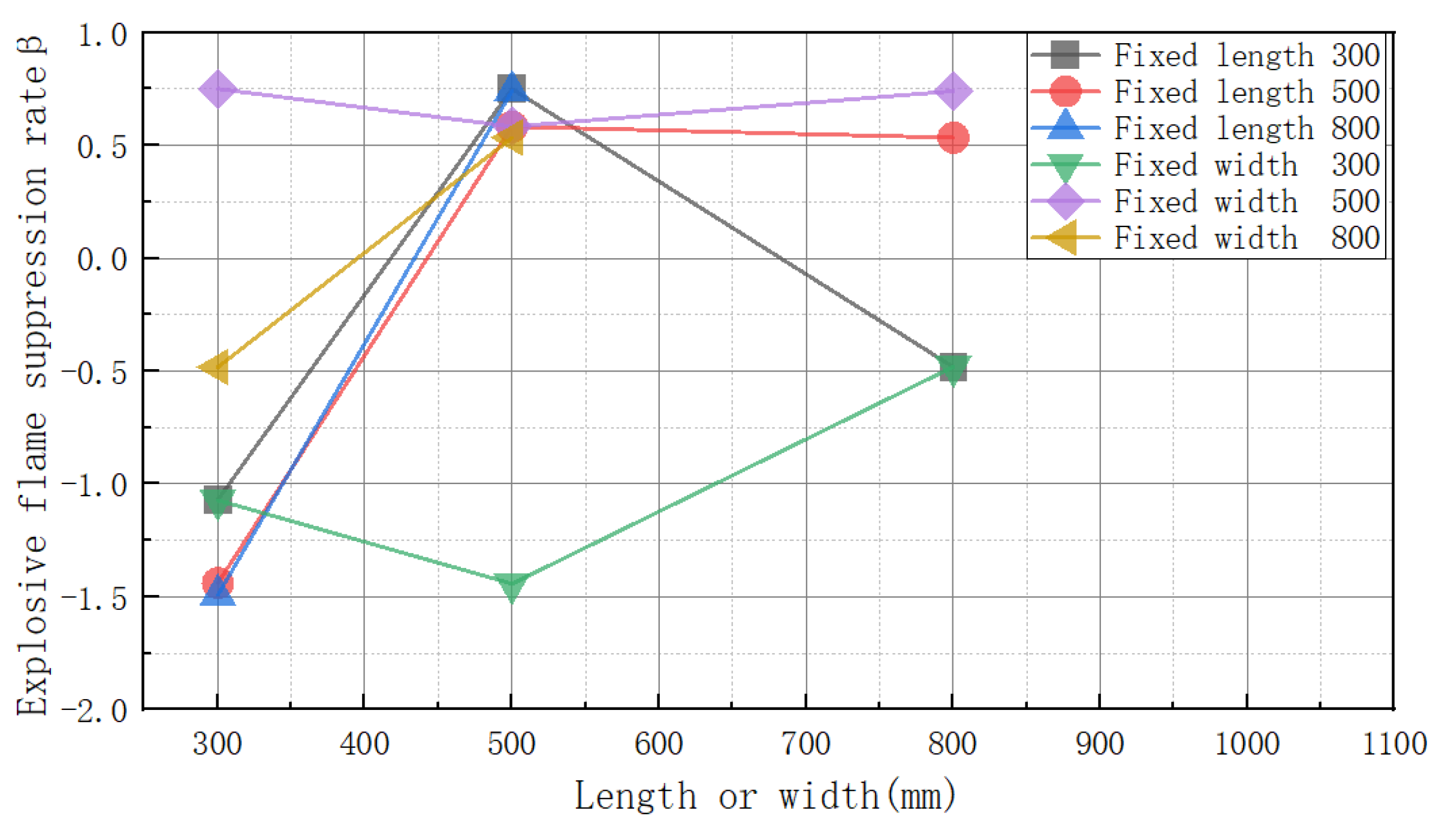

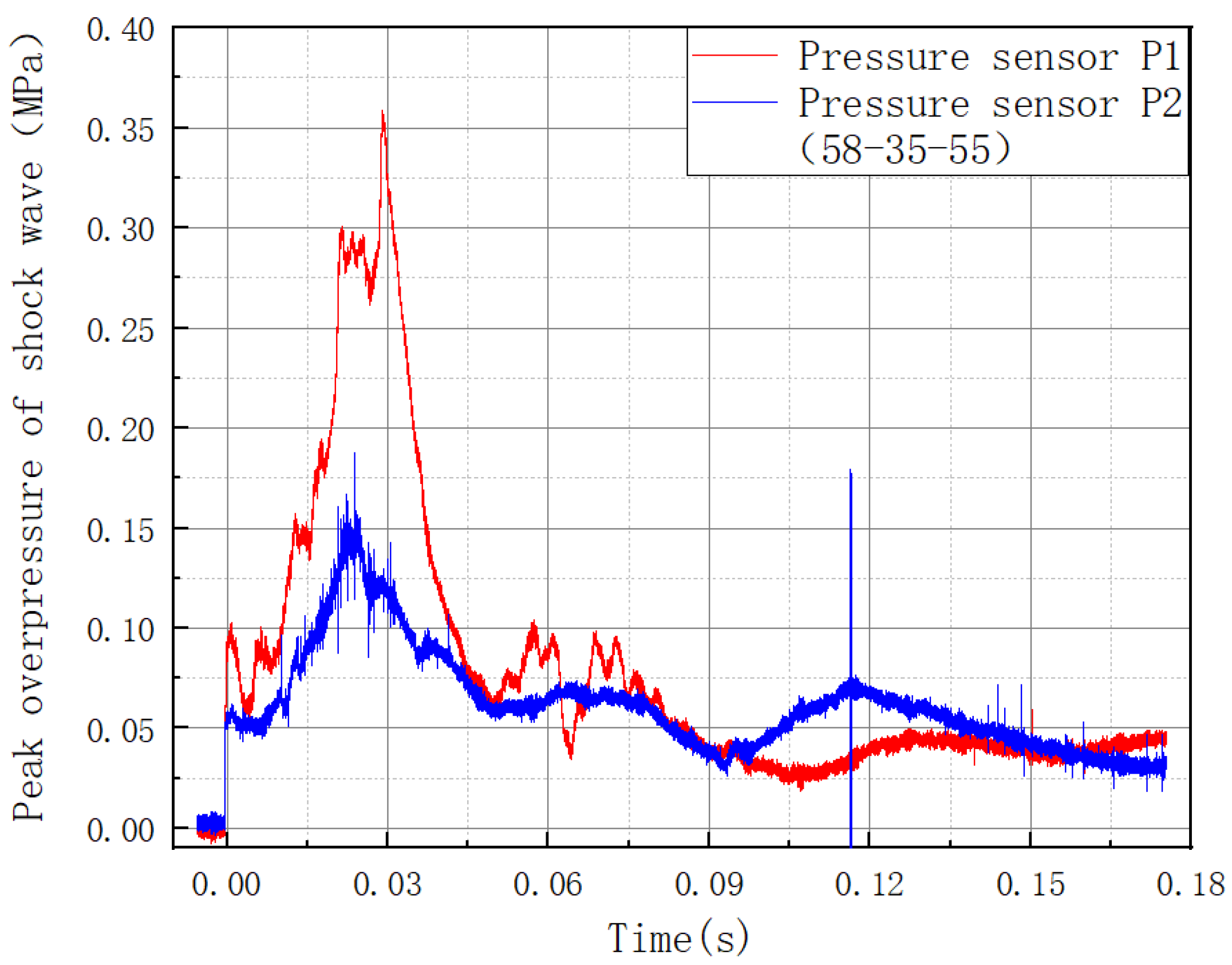
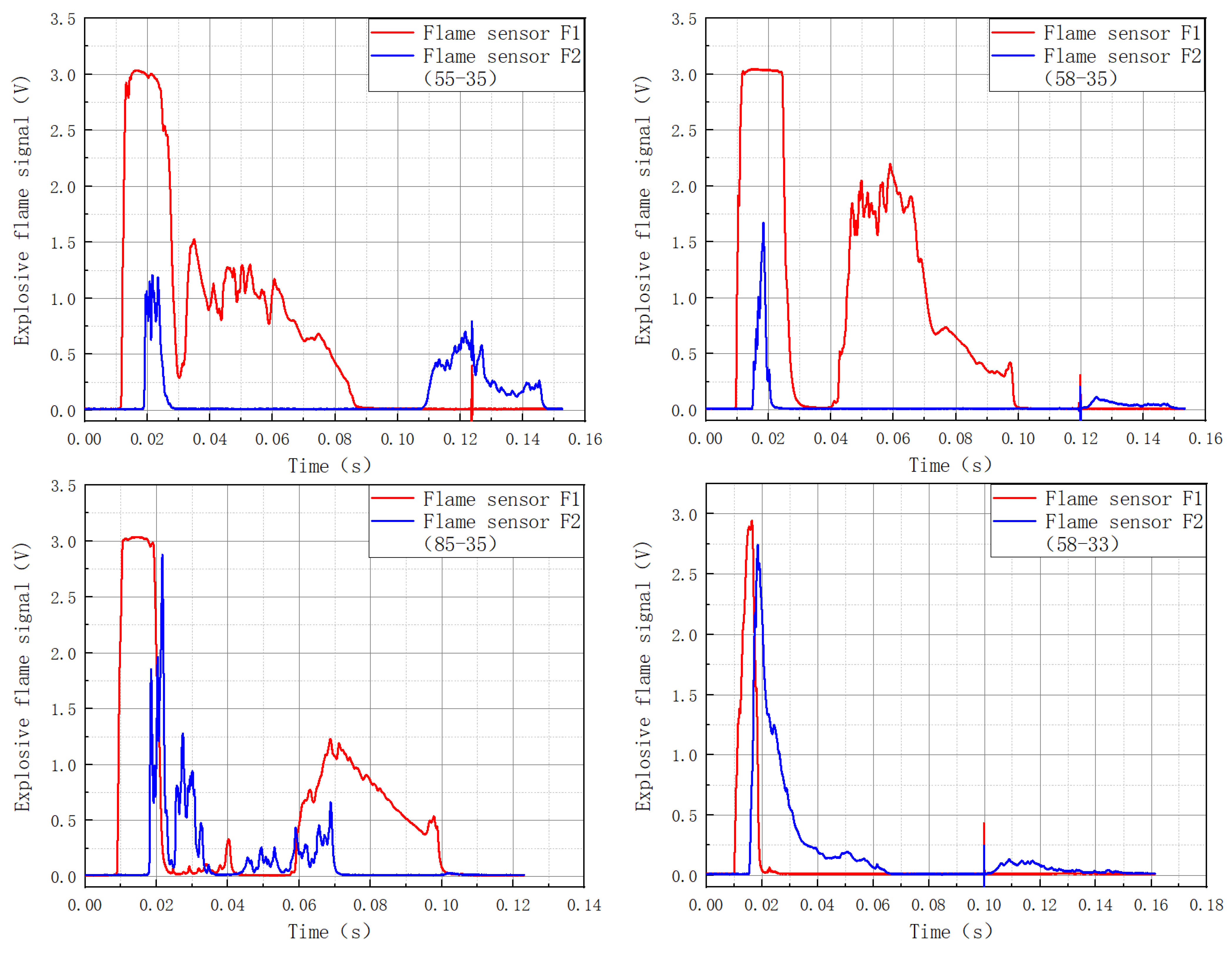
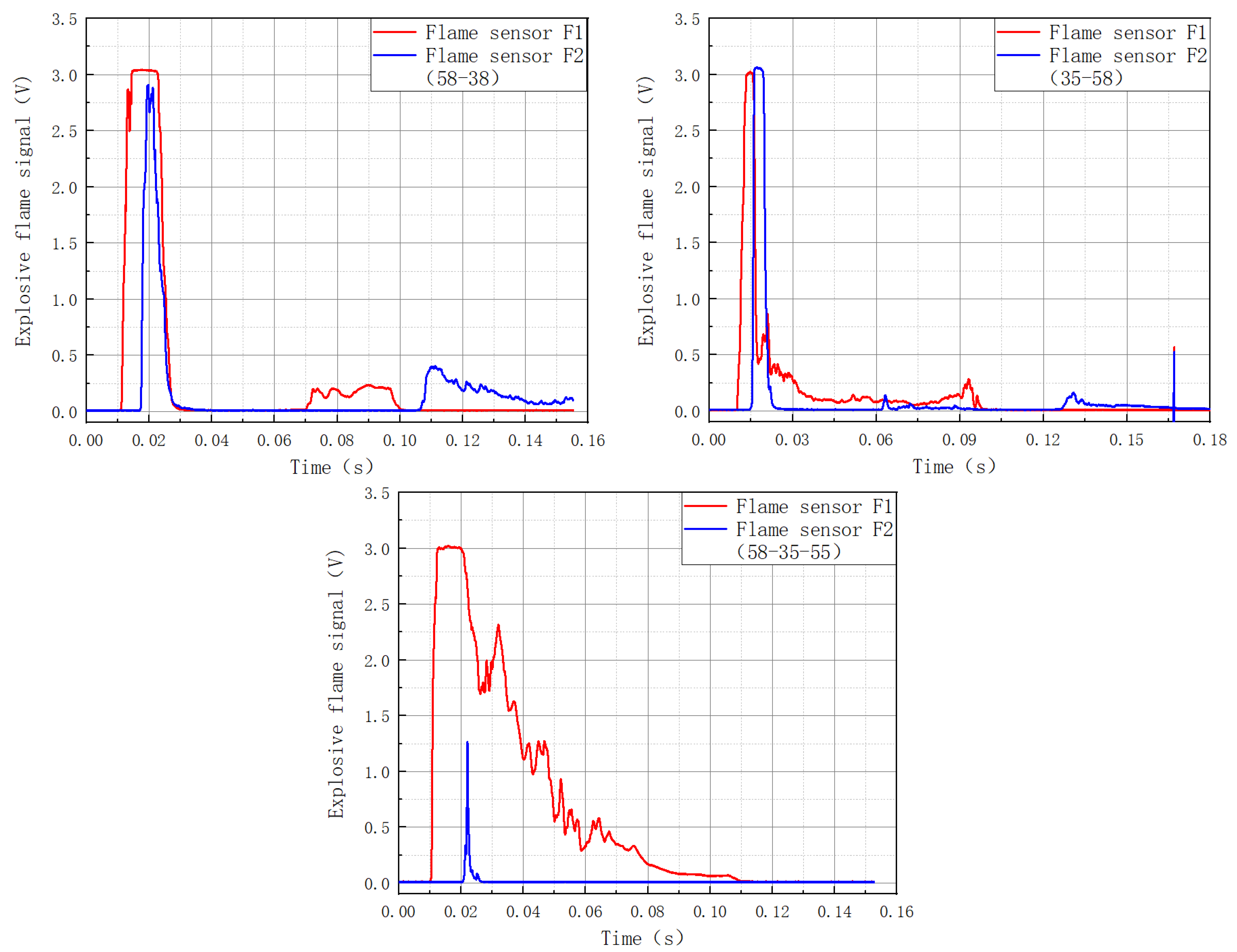


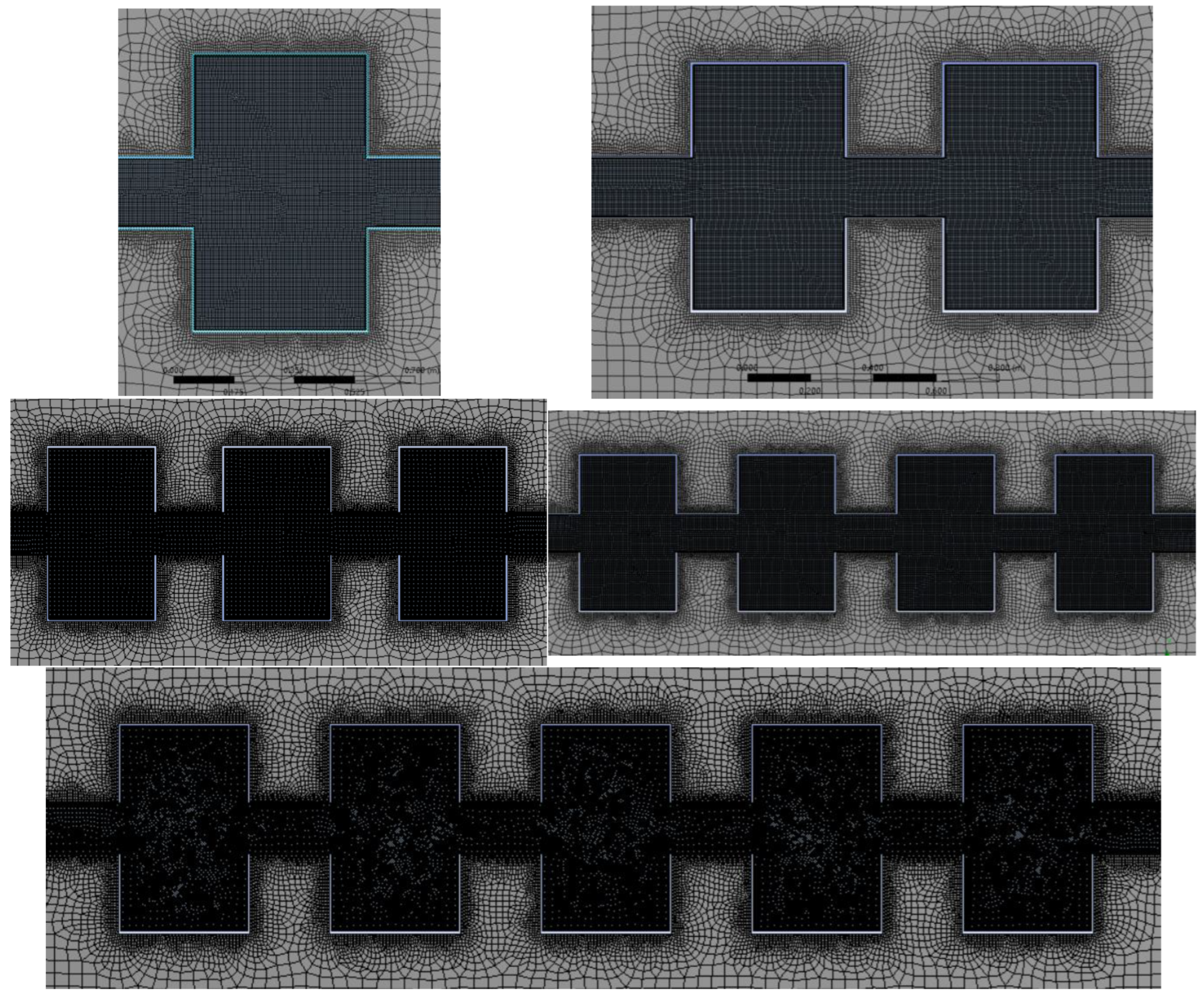
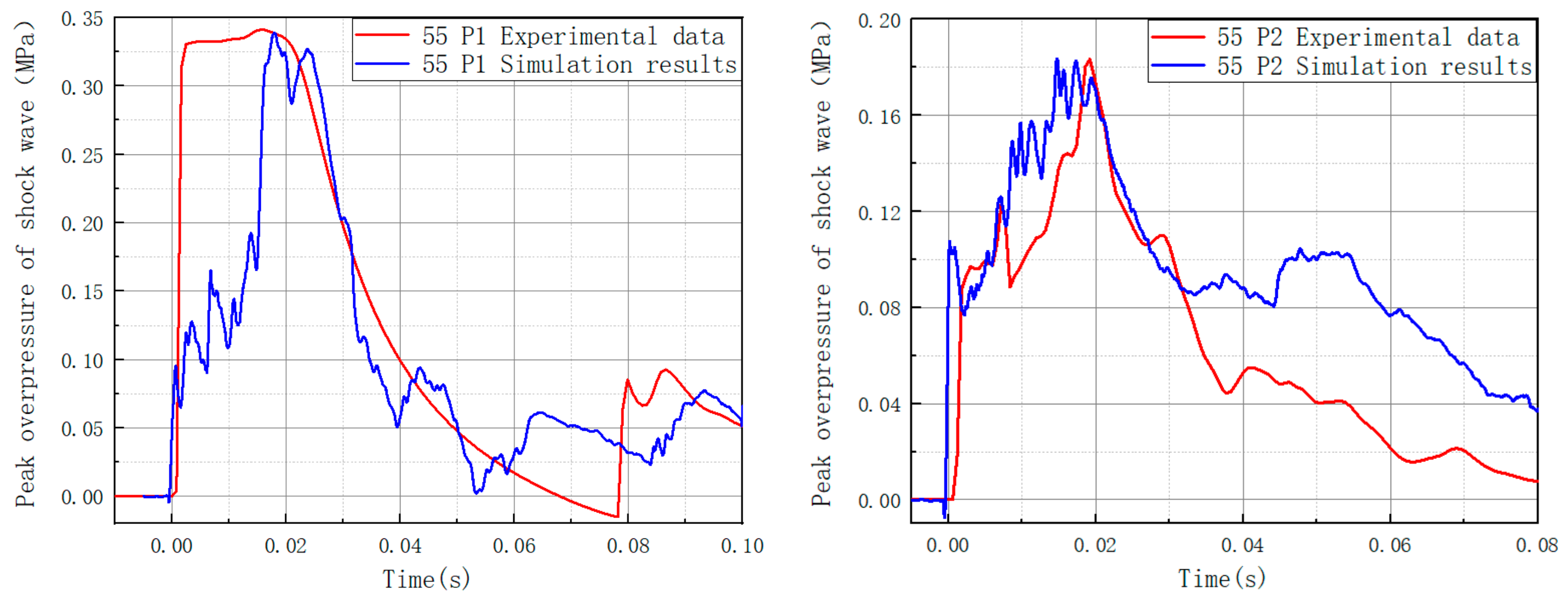
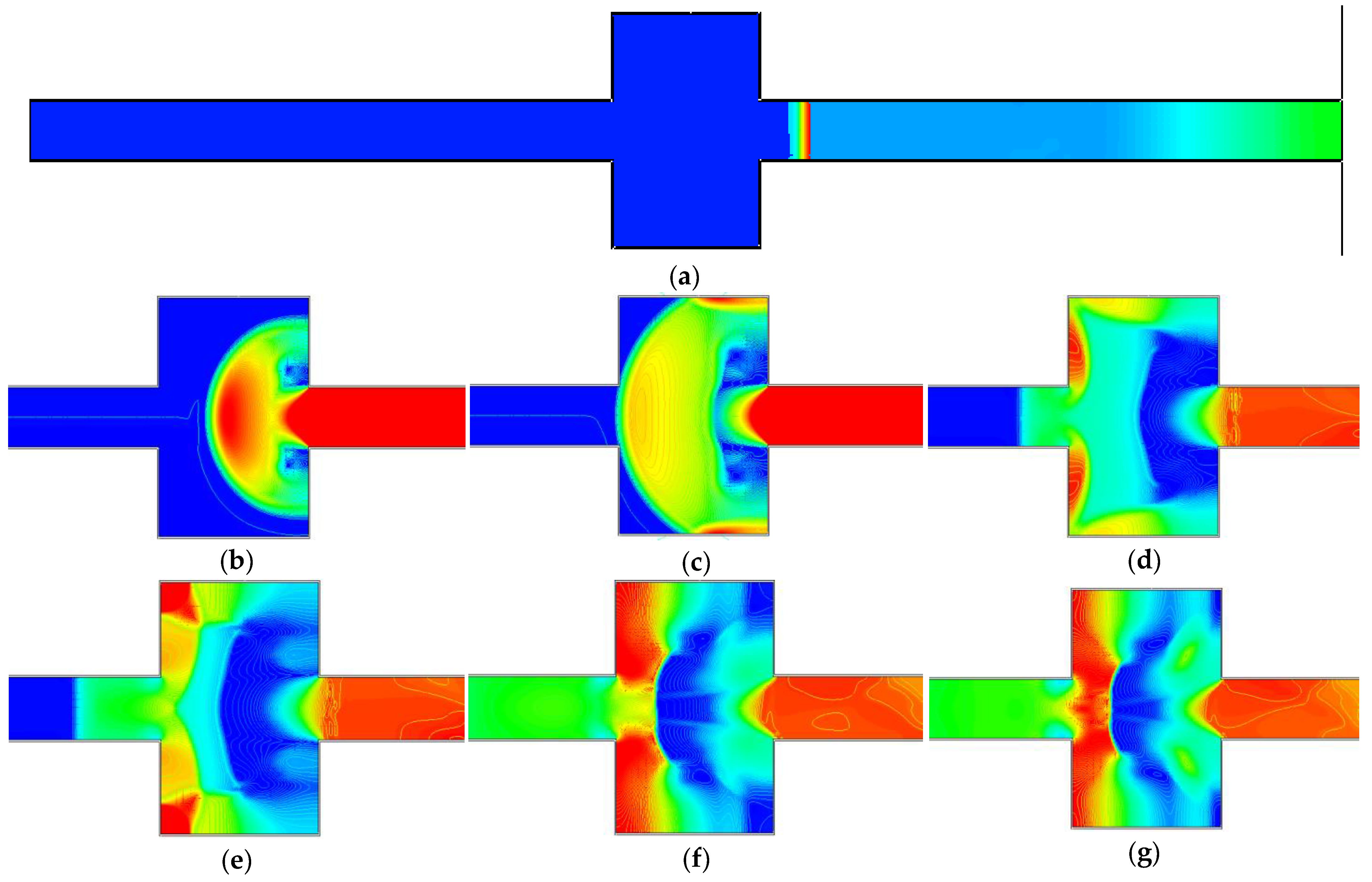
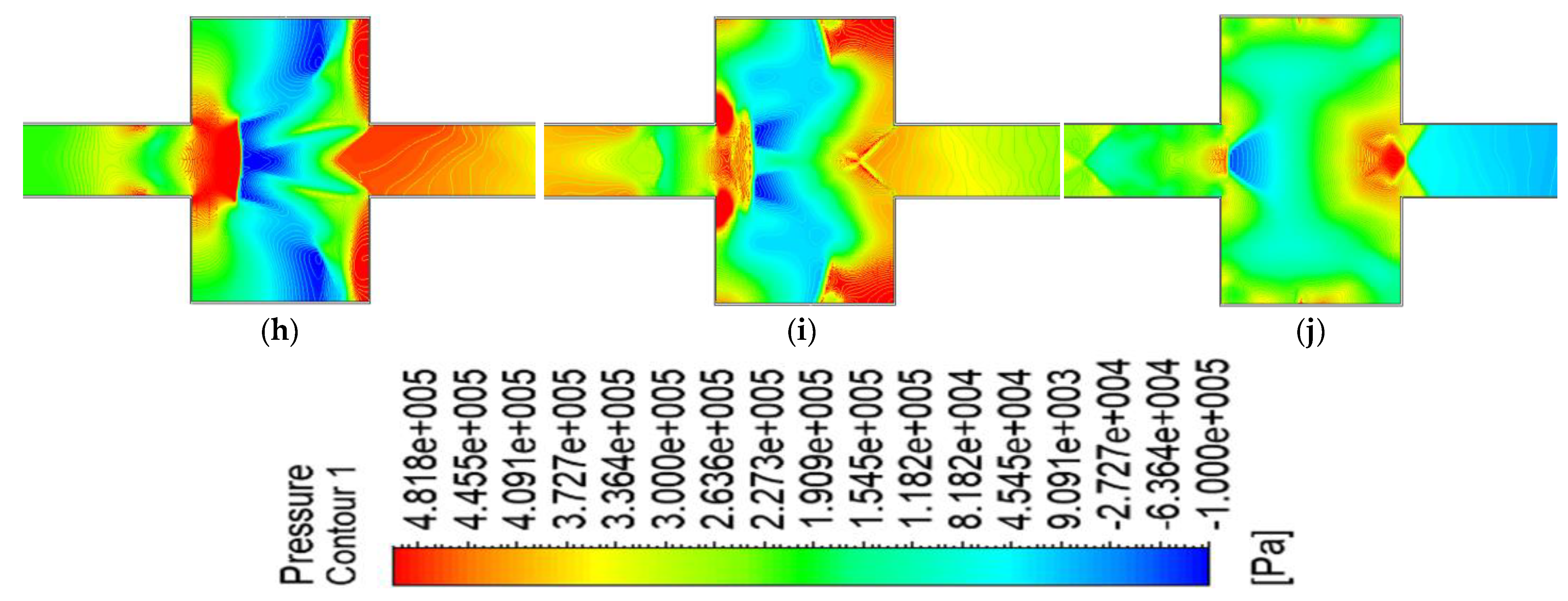

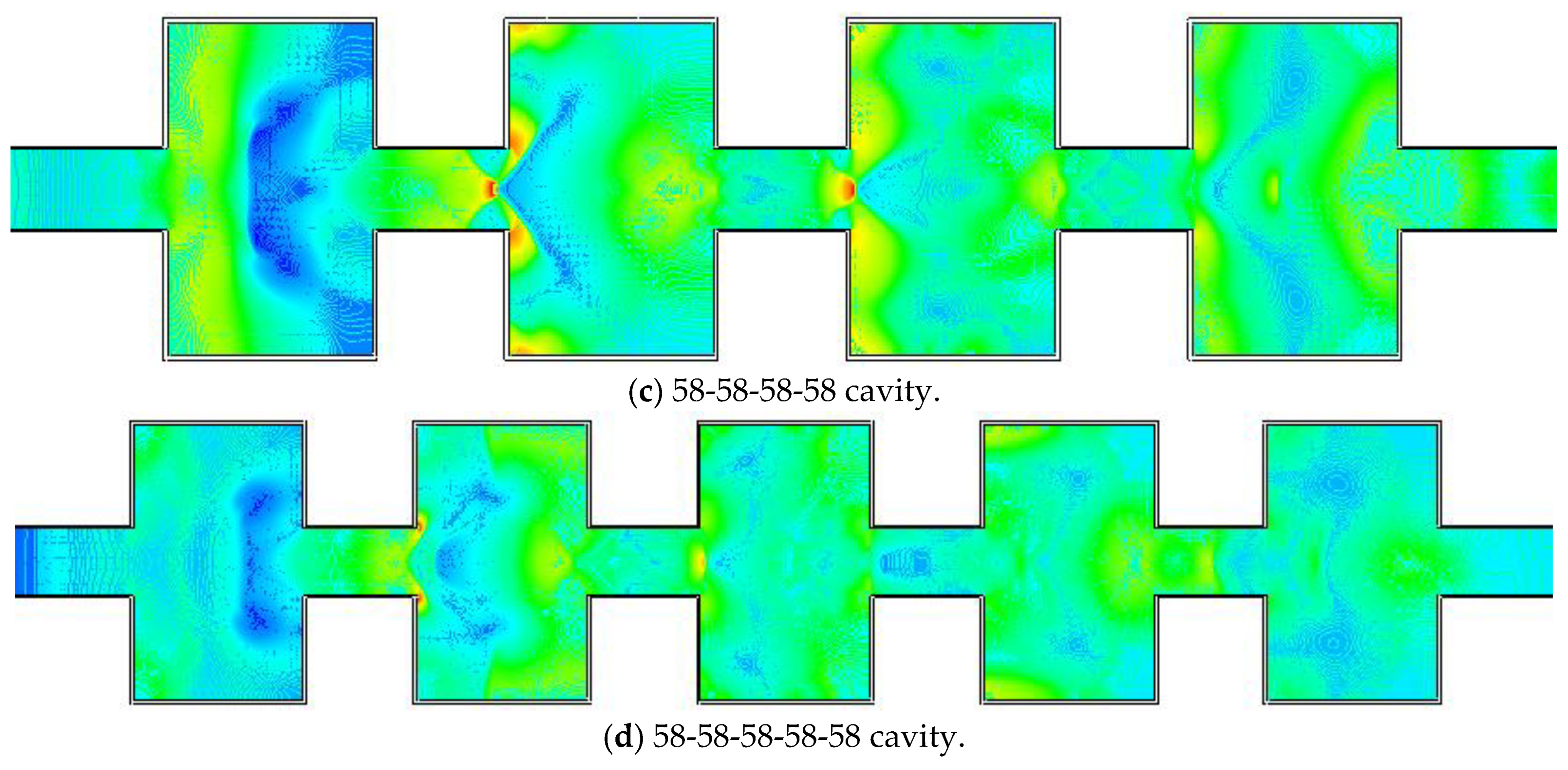
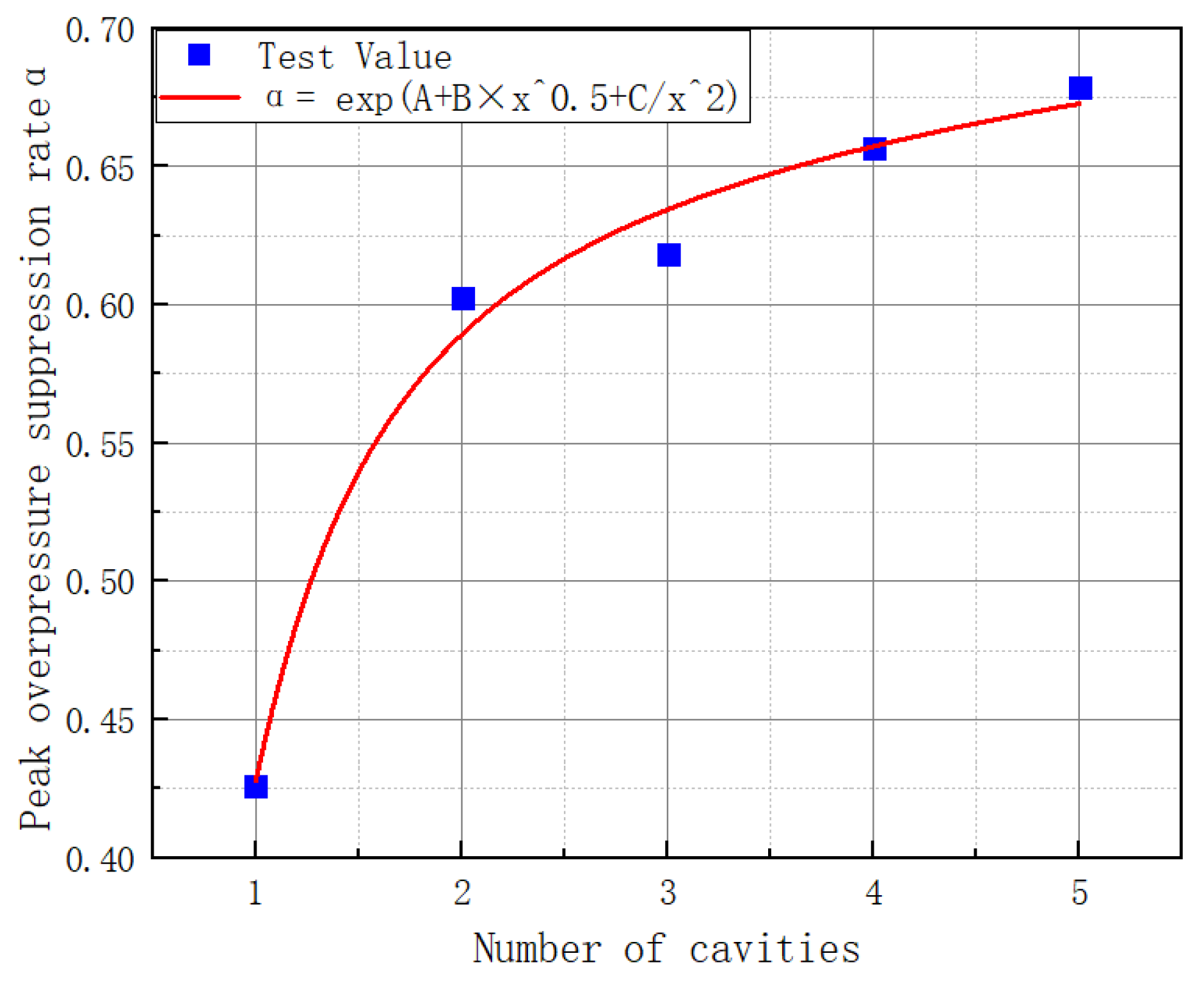
| Length (mm) | Width (mm) | Height (mm) | Experimental Photos | Schematic Model | |
|---|---|---|---|---|---|
| 1 | 300 | 300 | 200 |  |  |
| 2 | 300 | 500 | 200 |  |  |
| 3 | 300 | 800 | 200 | 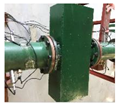 | 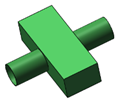 |
| 4 | 500 | 300 | 200 | 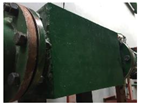 | 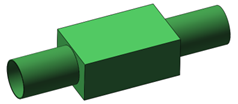 |
| 5 | 500 | 500 | 200 |  |  |
| 6 | 500 | 800 | 200 |  | 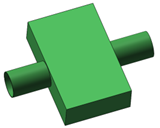 |
| 7 | 800 | 300 | 200 |  |  |
| 8 | 800 | 500 | 200 |  | 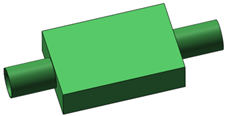 |
| Cavity Size (Length × Width × Height) | Abbreviation |
|---|---|
| 300 mm × 300 mm × 200 mm | 33 |
| 300 mm × 500 mm × 200 mm | 35 |
| 300 mm × 800 mm × 200 mm | 38 |
| 500 mm × 500 mm × 200 mm | 53 |
| 500 mm × 800 mm × 200 mm | 58 |
| 800 mm × 300 mm × 200 mm | 83 |
| 800 mm × 500 mm × 200 mm | 85 |
| Cavity Type | Area F1 | Area F2 | Rate of Explosion Flame Suppression |
|---|---|---|---|
| 33 | 0.0207 | 0.0429 | −107.25% |
| 35 | 0.1009 | 0.0251 | 75.12%% |
| 38 | 0.1121 | 0.1162 | −48.23% |
| 53 | 0.0422 | 0.1031 | −144.31% |
| 55 | 0.0173 | 0.0072 | 58.38% |
| 58 | 0.0385 | 0.0179 | 53.51% |
| 83 | 0.2547 | 0.2927 | −149.19% |
| 85 | 0.065 | 0.0167 | 74.11% |
| 33 | 35 | 38 | 53 | 55 | 58 | 83 | 85 | |
|---|---|---|---|---|---|---|---|---|
| Rate of peak overpressure suppression | −19.55% | −16.91% | −14.69% | −26.91% | 21.48% | 45.27% | −32.60% | 28.73% |
| 55-35 | 58-35 | 85-35 | 58-33 | 58-38 | 35-58 | 58-35-55 | |
|---|---|---|---|---|---|---|---|
| Pressure sensor P1(MPa) | 0.4778 | 0.3432 | 0.8403 | 0.5689 | 0.2769 | 0.2535 | 0.3584 |
| Pressure sensor P2(MPa) | 0.3283 | 0.2356 | 0.5925 | 0.3288 | 0.2048 | 0.1549 | 0.1622 |
| Rate of peak overpressure suppression | 31.29% | 31.35% | 29.49% | 42.21% | 26.04% | 38.89% | 54.74% |
| 55-35 | 58-35 | 85-35 | 58-33 | 58-38 | 35-58 | 58-35-55 | |
|---|---|---|---|---|---|---|---|
| Flame sensor F1 | 0.0945 | 0.1088 | 0.0649 | 0.0188 | 0.0434 | 0.0283 | 0.0929 |
| Flame sensor F1 | 0.0019 | 0.0072 | 0.0183 | 0.0293 | 0.0252 | 0.0185 | 0.0025 |
| Flame suppression rate | 79.78% | 93.38% | 71.80% | −55.85% | 42.73% | 34.63% | 97.31% |
Disclaimer/Publisher’s Note: The statements, opinions and data contained in all publications are solely those of the individual author(s) and contributor(s) and not of MDPI and/or the editor(s). MDPI and/or the editor(s) disclaim responsibility for any injury to people or property resulting from any ideas, methods, instructions or products referred to in the content. |
© 2023 by the authors. Licensee MDPI, Basel, Switzerland. This article is an open access article distributed under the terms and conditions of the Creative Commons Attribution (CC BY) license (https://creativecommons.org/licenses/by/4.0/).
Share and Cite
Chen, S.; Liu, W.; Mu, C. Research on the Rule of Explosion Shock Wave Propagation in Multi-Stage Cavity Energy-Absorbing Structures. Materials 2023, 16, 4608. https://doi.org/10.3390/ma16134608
Chen S, Liu W, Mu C. Research on the Rule of Explosion Shock Wave Propagation in Multi-Stage Cavity Energy-Absorbing Structures. Materials. 2023; 16(13):4608. https://doi.org/10.3390/ma16134608
Chicago/Turabian StyleChen, Shihu, Wei Liu, and Chaomin Mu. 2023. "Research on the Rule of Explosion Shock Wave Propagation in Multi-Stage Cavity Energy-Absorbing Structures" Materials 16, no. 13: 4608. https://doi.org/10.3390/ma16134608
APA StyleChen, S., Liu, W., & Mu, C. (2023). Research on the Rule of Explosion Shock Wave Propagation in Multi-Stage Cavity Energy-Absorbing Structures. Materials, 16(13), 4608. https://doi.org/10.3390/ma16134608





